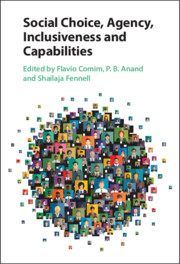Book contents
- Social Choice, Agency, Inclusiveness and Capabilities
- Social Choice, Agency, Inclusiveness and Capabilities
- Copyright page
- Contents
- Figures
- Tables
- Contributors
- Preface and Acknowledgements
- 1 Introduction: social choice, agency, inclusiveness and capabilities
- Part I Social Choice and Capabilities
- Part II Inclusiveness, Social and Individual Agency
- Part III Social Choice and Capabilities in Action
- 14 Measuring the independence of ‘dependent’ persons based on the capability approach
- 15 Indigenous challenges to the capability approach
- 16 Situating the family within the capabilities framework: a collective conversion factor
- 17 An ethical perspective on the United Kingdom’s Improving Lives: The Future of Work, Health and Disability
- 18 Public services as conversion factors
- Index
- References
18 - Public services as conversion factors
Exploring the theory and practice
from Part III - Social Choice and Capabilities in Action
Published online by Cambridge University Press: 28 March 2024
- Social Choice, Agency, Inclusiveness and Capabilities
- Social Choice, Agency, Inclusiveness and Capabilities
- Copyright page
- Contents
- Figures
- Tables
- Contributors
- Preface and Acknowledgements
- 1 Introduction: social choice, agency, inclusiveness and capabilities
- Part I Social Choice and Capabilities
- Part II Inclusiveness, Social and Individual Agency
- Part III Social Choice and Capabilities in Action
- 14 Measuring the independence of ‘dependent’ persons based on the capability approach
- 15 Indigenous challenges to the capability approach
- 16 Situating the family within the capabilities framework: a collective conversion factor
- 17 An ethical perspective on the United Kingdom’s Improving Lives: The Future of Work, Health and Disability
- 18 Public services as conversion factors
- Index
- References
Summary
Public service reform in the shape of collaborative governance is consistently promoted by statutory actors in Scotland and other high-income countries to help develop high-quality and efficient public services, responsive to peoples needs, but this notion contains a number of weaknesses. This chapter explores the potential of the capabilities approach (CA), conversion factors in particular, to achieve a more effective model for conceptualizing, driving and evaluating how public services operate, drawing on empirical work conducted by What Works Scotland. It argues that the CA provides an ethical framework for evaluating the role and function of public services in safeguarding peoples well-being and social justice, especially for those with fewest resources. Employing data from two research projects in areas of multiple deprivation, the impact of public service interventions is evaluated in terms of conversion factors, and how these shape outcomes for citizens and communities. The concept of structural conversion factors is an innovative response to criticism of the CA, and the chapter argues that this modification allows it to better confront the drivers of social injustice.
- Type
- Chapter
- Information
- Social Choice, Agency, Inclusiveness and Capabilities , pp. 401 - 422Publisher: Cambridge University PressPrint publication year: 2024

